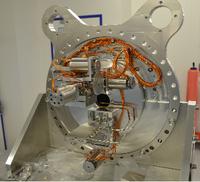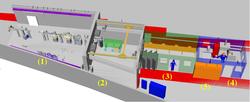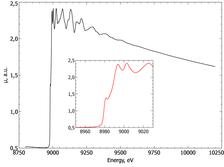Assembly of the c-type DCM in the clean room
P65 is designed to provide beamtime for the type of applications that use X-ray absorption fine structure spectroscopy (XAFS) as an analytical method to solve a multitude of scientific questions. Applications stem from so diverse fields of science as chemistry - especially catalysis and battery research -, materials science, biology, environmental- and geosciences. Many of these applications have a direct or indirect connection to industrial motivated research. This type of research demands an easy to use, stable and robust set-up for standard XAFS experiments.
The beamline provides a relatively large beam (0.5x1 mm2) and a moderate photon flux density. The 11 period undulator delivers a maximum monochromatic photon flux of 2*1012 s-1 at 9 keV and more than 1011 s-1 at the higher end of the working range. Two plane mirrors with variable angle of incidence and three different surface coatings are installed in front of the water cooled double crystal monochromator (DCM). They reduce the power load density on the first DCM crystal and effectively suppress the contamination of the monochromatic X-ray beam with higher harmonics radiation. The main factor for the very high stability of the beam position on the sample is the short distance of only 5 m between the dCM and the sample position.
The experimental hutch has a size of approximately 4 x 6 m2. The height of the ceiling in the hutch is 4 m, this is high enough to mount for instance a He-transfer tube in the standard dewar bottles for liquid helium. Access to the hutch is possible via a large sliding door at the end of the hutch. In the lateral direction the distance between the beam and the wall of the experimental hutch is about 0.6 m on the left hand side (looking downstream) and 3 m on the right hand side. The experimental hutch is equipped with the complete infrastructure for in-situ experiments with all kinds gases and liquids. Samples can be prepared in a sample preparation lab adjacent to the beamline.
Before submitting a proposal please contact the beamline manager to check the availability of certain experimental equipment and the feasibility of your planned experiment!
3D model of beamline P65, (1) optics hutch, (2) experimental hutch, (3) control hutch, (4) sample preparation lab, (5) gas cabinets for problematic gases.
|
Beamline Stats |
|
|---|---|
|
Source: |
Mini-undulator (11 periods) |
|
Energy Range: |
4 - 44 keV |
|
Accessible Elements: |
K-edges: Ca - Nd |
|
Monochromator: |
C-type Mono (fixed exit) |
|
Mirrors: |
2 plane mirrors for higher harmonic rejection, variable incidence angle (1.8 - 4 mrad) |
|
Beamsize at Sample: |
0.5 x 1 mm2 (vert x hor) |
|
Photon flux at Sample |
>1011 - 10 12 s -1 |
|
Bandwidth |
10-4 |
|
Methods |
|---|
|
X-ray absorption spectroscopy in transmission and fluorescence mode. |
|
Detectors |
|---|
|
Ionisation Chambers |
|
Energy dispersive 4 pixel SDD-detector |
|
Si-PIPS diodes |









